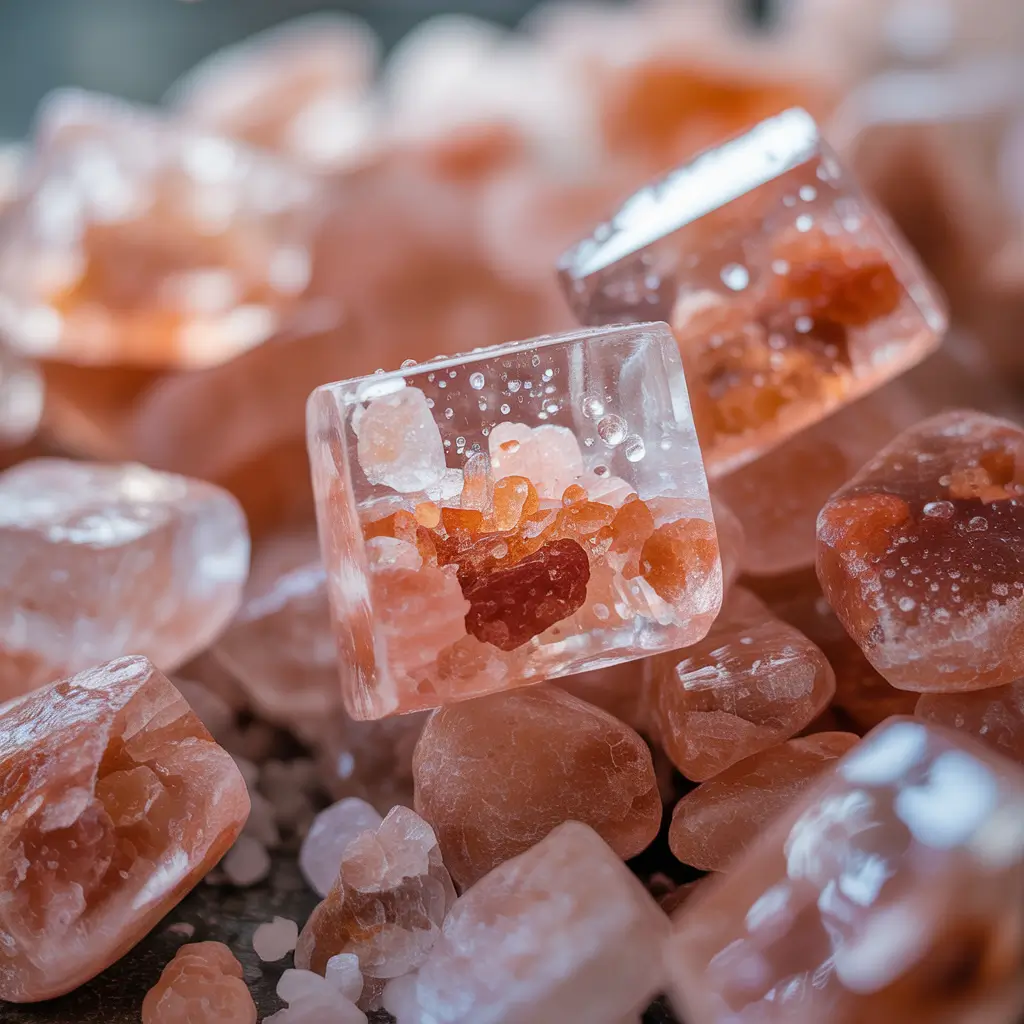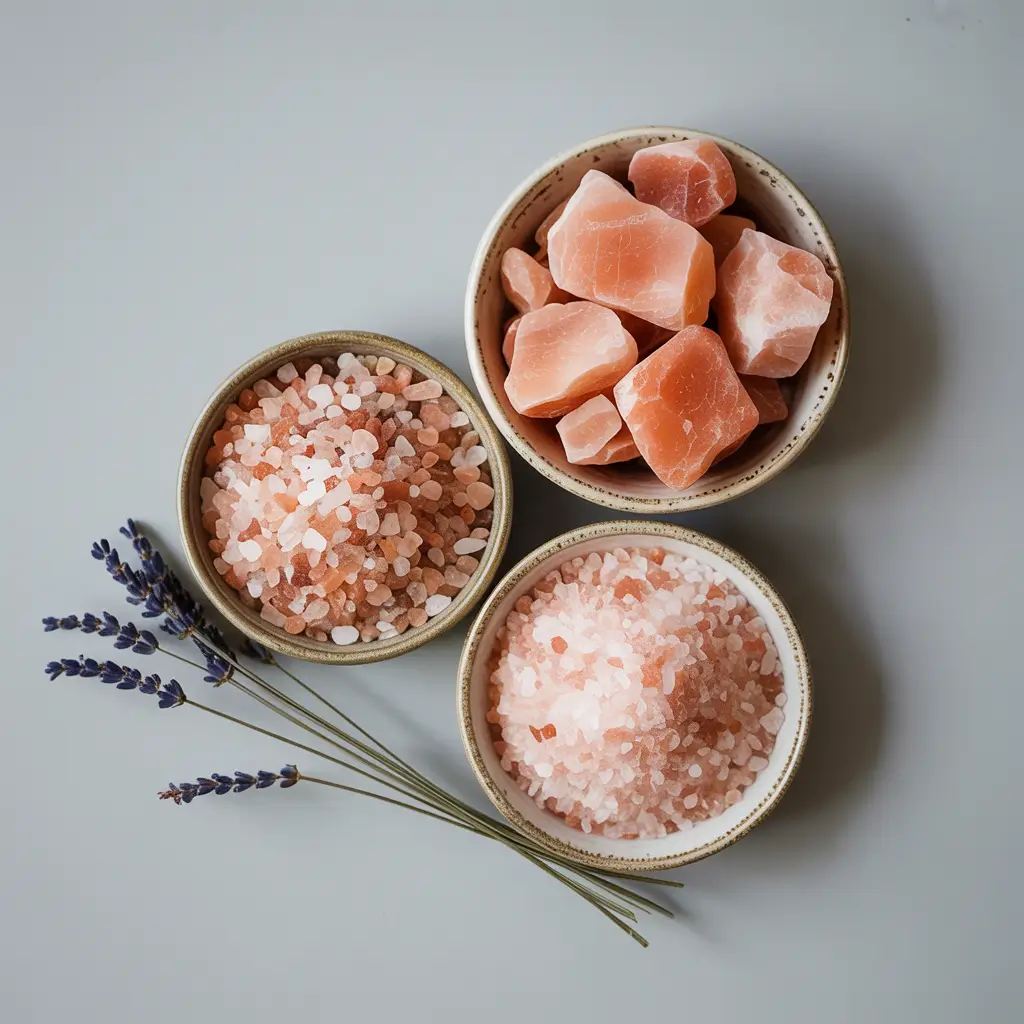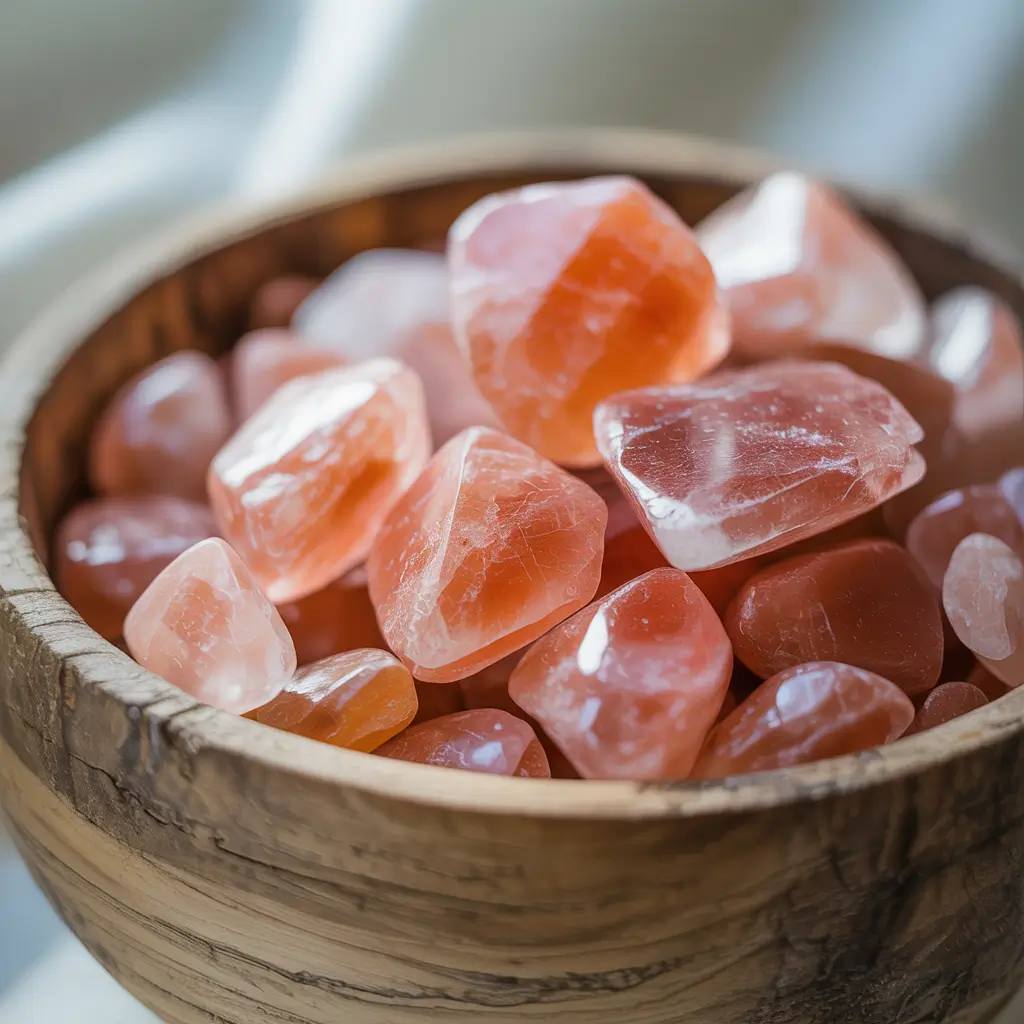Introduction
Pink Tibetan salt has become one of the most talked-about natural salts in the health and wellness space. With its blush color and mineral-rich content, it’s not just a pretty alternative to regular salt—it’s a product steeped in tradition, often linked to detoxification, energy balance, and even spiritual rituals.
Sourced from the high-altitude salt beds of the Himalayas bordering Tibet, this salt is celebrated for being pure, unrefined, and packed with trace elements the body needs. From TikTok trends to wellness blogs, pink salt is everywhere—but how much of it is real science, and how much is marketing?
This article explores what pink Tibetan salt is, where it comes from, and how it compares to other salts. We’ll also look into its claimed benefits, daily uses, and whether the popular pink salt detox really delivers.
Don’t miss our Japanese Pink Salt and Ice Recipe: The Viral Detox Trick Explained to see why people are adding pink salt to ice water every morning.Stay updated on the latest natural health trends by following our Facebook page for simple, effective wellness tips.
Pink Tibetan Salt: Benefits, Truths & Detox Myths Revealed
A quick and natural morning drink using pink Tibetan salt to support hydration, digestion, and mineral balance.
- Prep Time: 3 minutes
- Cook Time: 0 minutes
- Total Time: 3 minutes
- Yield: 1 glass 1x
- Category: Detox Drink
- Method: No-Cook
- Cuisine: Wellness / Natural
- Diet: Vegan
Ingredients
-
1 glass of filtered room-temperature water
-
¼ teaspoon pink Tibetan salt (food-grade only)
-
Juice of ½ fresh lemon
-
(Optional) 1–2 ice cubes for a chilled version
Instructions
-
Pour the filtered water into a glass.
-
Add the pink salt and stir until fully dissolved.
-
Squeeze in the fresh lemon juice and stir again.
-
Drink slowly on an empty stomach, ideally in the morning.
Notes
-
Use only food-grade pink Tibetan salt—do not substitute with bath salts.
-
Avoid overuse; 1 serving per day is enough.
-
You can prepare a week’s worth by storing it in the fridge, but shake before drinking.
-
Not recommended for people on a low-sodium diet without medical advice.
Nutrition
- Serving Size: 1
- Calories: 5
- Sodium: 380 mg
Keywords: pink Tibetan salt, detox drink, natural hydration, pink salt lemon water, sole water
Understanding Pink Tibetan Salt
Defining Pink Tibetan Salt
Pink Tibetan salt is a naturally occurring rock salt with a light pink tint due to its mineral makeup. Unlike processed table salt, it isn’t bleached or chemically treated. It’s harvested in crystal form and contains minerals like calcium, magnesium, potassium, and iron—essential elements for hydration and overall wellness.
Because it’s minimally processed, it retains its original structure and nutrients, making it a popular choice among those looking for a clean, natural seasoning or holistic health solution.
Where It’s Mined and How It Forms
Despite its name, pink Tibetan salt often comes from ancient salt deposits located in Himalayan regions near Tibet, not just Tibet itself. These deposits formed millions of years ago when oceans evaporated, leaving behind dense layers of salt buried beneath the mountains.
Miners extract the salt by hand or with simple tools, keeping its natural properties intact. Once collected, it’s typically sun-dried, crushed, and sold in various textures—from coarse rock chunks to fine powder.
Want to try pink salt in your diet? Discover great ideas like the Recipe for Pink Salt: A Simple Detox You Can Make at Home.
Why Is Tibetan Salt Pink?

What Gives Pink Tibetan Salt Its Color?
The soft pink glow of pink Tibetan salt is more than just a pretty feature—it’s the result of naturally embedded minerals. The key player is iron oxide, a compound that gives the salt its rosy shade. The pink tint becomes more intense depending on the mineral concentration and the depth from which the salt is mined.
Beyond iron, pink salt contains a mix of over 80 trace elements including calcium, potassium, and magnesium. These minerals not only influence the color but also enhance the salt’s health properties, making it richer in nutrients compared to white refined salt.
This mineral density is one reason why many health-conscious consumers prefer pink salt—it delivers more than just flavor.
How Pink Tibetan Salt Differs from Other Salts
It’s easy to confuse pink Tibetan salt with Himalayan pink salt, but they’re not always harvested from the same place. Tibetan salt usually comes from higher elevations and smaller mining regions closer to Tibet, while Himalayan salt is often sourced from the Khewra Salt Mine in Pakistan.
Then there’s sea salt, which is produced by evaporating seawater. While natural sea salt can contain minerals, it’s often exposed to modern ocean pollutants. In contrast, pink salt is mined from fossilized seabeds, formed millions of years ago—long before modern pollution existed.
Refined table salt, meanwhile, is heavily processed and stripped of most minerals, leaving behind mostly sodium chloride. It’s often blended with anti-caking agents and additives, which are absent in pink salt.
Here’s a quick breakdown:
| Salt Type | Source | Color | Mineral Content | Purity Level |
|---|---|---|---|---|
| Pink Tibetan Salt | Ancient salt beds near Tibet | Light to deep pink | Very High | Unrefined/Natural |
| Himalayan Salt | Pakistan (Khewra Mine) | Light pink | High | Unrefined |
| Sea Salt | Evaporated ocean water | White/Grey | Moderate | May be refined |
| Table Salt | Industrial salt processing | Pure white | Very Low | Highly refined |
Don’t miss our Japanese Pink Salt Recipe: The Natural Detox Trick That’s Going Viral to see how this mineral-packed salt is trending in modern wellness routines.
The Pink Salt Trick – Truth or Hype?
What Is the Pink Salt Trick Everyone’s Talking About?
If you’ve been scrolling social media lately, chances are you’ve seen the pink salt and ice detox trick pop up. This viral trend usually involves mixing pink Tibetan salt with cold water, ice cubes, and lemon juice, and drinking it first thing in the morning. Advocates claim it can flush toxins, speed up metabolism, and even help with weight loss.
The idea behind this “trick” is based on the belief that the salt helps balance electrolytes and cleanse the body, while the lemon provides vitamin C and boosts digestion. Sounds simple enough—but is there real science behind it?
Does Pink Tibetan salt Actually Work? Here’s What Experts Say
There’s a bit of truth behind the trend—but not the whole story. Drinking salt water in small amounts can help hydrate the body, especially when it’s rich in natural minerals like those found in pink Tibetan salt. These minerals support fluid balance, nerve function, and energy production.
However, the claims of rapid detox or fat burning are not scientifically proven. Your kidneys and liver already do the heavy lifting when it comes to detoxification. Salt water can support that process, but it won’t magically “cleanse” your body overnight.
That said, when used in moderation, pink salt water—sometimes called sole water—can be a useful wellness habit. It may help improve digestion, hydrate faster than plain water, and restore lost minerals after sweating or fasting.
But moderation is key. Too much salt, even the natural kind, can spike sodium levels and lead to bloating or high blood pressure in sensitive individuals.
PRO TIP: Start with a pinch of pink salt in a full glass of room-temperature water, and always consult your healthcare provider before starting any detox routine.
Don’t miss our full guide: Japanese Pink Salt and Ice Recipe: The Viral Detox Trick Explained to see how this method is being used and modified.
Health Benefits of Pink Tibetan Salt
Supports Hydration and Electrolyte Balance
One of the most talked-about benefits of pink Tibetan salt is its ability to support hydration. Unlike regular table salt, this natural variety contains trace minerals like potassium, calcium, and magnesium—elements your body uses to maintain fluid balance.
When mixed with water, even a small amount of pink salt can help your body absorb water more effectively. This is especially helpful for those who are active, fasting, or recovering from dehydration. It’s not just about salt—it’s about the minerals that come with it.
May Aid Digestion and Mineral Absorption
Many holistic health practitioners recommend starting your day with a glass of warm water mixed with pink salt. Why? Because it’s believed to stimulate digestive enzymes and encourage stomach acid production, which can help your body break down food more efficiently.
Pink salt’s natural mineral profile also helps with nutrient absorption. When your gut works properly, your entire body benefits—from better energy levels to reduced bloating.
Can Help Restore Mineral Levels
If you’re sweating, fasting, or following a low-sodium diet, you might lose essential minerals without even realizing it. Pink Tibetan salt offers a way to gently restore those levels without relying on synthetic supplements. It’s also used in sole water, a traditional remedy made by soaking salt in water overnight and sipping it daily.
Discover how to enjoy it every day in this Recipe for Pink Salt: A Simple Detox You Can Make at Home.
Calming Effects and Better Sleep
There’s some evidence—both anecdotal and scientific—that pink salt may help calm the nervous system. Magnesium, in particular, is known for promoting relaxation and improving sleep quality. While the levels in salt are low, adding it to a calming bedtime drink or bath soak could help you wind down more easily.
Looking for a relaxing recipe to try? Don’t miss our Japanese Pink Salt Recipe: The Natural Detox Trick That’s Going Viral.
How to Use Pink Tibetan Salt Daily

In Cooking and Everyday Meals
One of the easiest ways to enjoy pink Tibetan salt is by simply swapping it with your regular table salt. It works beautifully in seasoning meats, vegetables, soups, and even baked goods. Many people say it gives a more rounded, slightly earthy flavor compared to regular salt.
You can also use it to finish dishes—sprinkle a pinch over roasted potatoes, avocado toast, or grilled salmon for a gourmet touch and added minerals.
Since pink salt has larger crystals, it’s best to measure by weight, not volume, especially if you’re following precise recipes.
As a Morning Detox Drink
Start your day with a DIY detox water. Just dissolve a pinch of Pink Tibetan salt in a glass of warm water, and add a squeeze of fresh lemon. This combo can help kickstart digestion, support hydration, and replace minerals lost during sleep.
This drink is especially popular with intermittent fasters, athletes, and wellness enthusiasts who want a natural way to rehydrate in the morning.
Want a step-by-step guide? Check out the Recipe for Pink Salt: A Simple Detox You Can Make at Home for a simple, energizing version.
In Relaxing Bath Soaks
Pink Tibetan salt isn’t just for eating—it’s also used in salt baths. Add 1 to 2 cups of the salt to warm bathwater and soak for 20–30 minutes. The minerals absorb through your skin, which may help ease sore muscles and relax your body after a long day.
It’s a natural alternative to Epsom salt and ideal for people who want a more holistic self-care routine.
For Oral Care and Skin Scrubs
Some people use a pink salt rinse to cleanse their mouths naturally. A small amount dissolved in warm water can help reduce bacteria and soothe gums.
You can also make a quick exfoliating scrub by mixing fine pink salt with coconut oil or honey. Gently rub it on your skin in circular motions to remove dead skin cells and boost circulation.
Looking for something truly refreshing? Try this Cucumber Lemonade with Mint: The Most Refreshing Drink for Your Summer Detox.Discover more pink salt wellness ideas on our Pinterest account, featuring homemade recipes and 100% natural DIY inspiration.
What Makes Pink Salt Special?
A Rich Source of Trace Minerals
What sets pink Tibetan salt apart from regular salt isn’t just the hue—it’s the nutrient profile. This salt contains more than 80 trace minerals, many of which are vital for everyday bodily functions. These include:
- Magnesium – supports muscle function and energy
- Calcium – essential for bone health
- Potassium – balances fluids and supports heart health
- Iron – improves oxygen flow and reduces fatigue
These naturally occurring minerals are what give pink salt its reputation as a mineral-rich super salt, offering more than just sodium chloride.
It’s Unrefined and Untreated
Unlike commercial table salt, which is often stripped of nutrients and bleached for appearance, pink Tibetan salt is harvested and packed with minimal processing. It’s usually mined by hand and sun-dried, preserving its original structure.
There are no added chemicals, anti-caking agents, or synthetic ingredients—which is why it appeals to those seeking clean, natural food products. This purity is one reason holistic healers, wellness experts, and natural chefs prefer it.
Used in Traditional and Spiritual Practices
In Tibetan and Ayurvedic traditions, salt isn’t just food—it’s a healing tool. Pink salt has long been used in cleansing rituals, energy balancing, and detoxification therapies.
From being used in temple offerings to purifying spaces, salt plays a key role in Eastern wellness philosophy. Its grounding energy and mineral content make it a symbol of stability, strength, and nourishment in traditional healing systems.
Don’t miss our Japanese Pink Salt Recipe: The Natural Detox Trick That’s Going Viral to see how old rituals are inspiring today’s health trends.Want to deepen your natural wellness routine? Visit Zestolla.com, a trusted resource for holistic nutrition and energy-based healing.
Why Is Pink Salt So Expensive?
Labor-Intensive Harvesting Methods
One of the biggest reasons pink Tibetan salt carries a higher price tag is the way it’s harvested. Unlike mass-produced table salt, this salt is often mined by hand from deep within ancient salt deposits. These deposits are located in remote, mountainous regions bordering Tibet and the greater Himalayas.
Getting to the salt, extracting it without machinery, and transporting it across rugged terrain requires time, effort, and careful handling. This labor-intensive process naturally raises the cost of production.
Small-Scale and Ethical Sourcing
Many of the sources for authentic pink Tibetan salt are small, family-run operations, not large-scale manufacturers. These producers prioritize quality and sustainability over volume. Ethical sourcing, fair labor, and traditional methods all add to the salt’s value—and its price.
Because pink salt isn’t refined or processed in bulk, the cost stays relatively high, especially for premium, food-grade crystals intended for health use.
Purity and Rarity
Pink salt’s color, mineral content, and unprocessed nature make it a specialty product. While Himalayan pink salt is more widely available, salt mined specifically near the Tibetan plateau is rarer and considered purer by some.
This level of purity and exclusivity contributes to its luxury image, which is reflected in the pricing. People are willing to pay more for a product they believe is cleaner, healthier, and more natural than supermarket alternatives.
High Demand in Health and Wellness Markets
The wellness industry has helped drive up demand. From gourmet chefs to holistic practitioners, pink salt is seen as more than just seasoning—it’s positioned as a health-enhancing ingredient.
With increasing attention from influencers and health-conscious consumers, prices have risen along with its popularity. It’s now found not just in kitchens, but in detox kits, bath soaks, and even skincare.
Check out the Fruit Riot Warhead – The Ultimate Sour Candy Experience in 2025 for a look at another trending item that balances taste and uniqueness.
Risks, Myths & Misconceptions
Myth 1: Pink Salt Is a Miracle Detox Cure
One of the biggest myths about pink Tibetan salt is that it can “cleanse your body” or remove toxins instantly. While it does contain minerals that support hydration and digestion, no salt alone can detox your body. Your liver and kidneys already do that job every day.
Drinking pink salt water (often called sole water) in small amounts can help replenish minerals, but it won’t magically eliminate toxins or make you lose weight overnight.
Myth 2: The Pinker the Salt, the Better the Quality
This one sounds logical—but it’s not entirely true. Yes, the pink color comes from mineral content, especially iron. But color alone doesn’t determine nutritional value.In fact, deeply colored pink salt may have excessively high iron content, which can lead to a metallic or bitter taste and may not be ideal for regular consumption.
Always look for food-grade labels and avoid assuming that deeper color equals better health benefits.
Myth 3: Pink Salt Has No Sodium Issues
Many assume that because it’s “natural,” pink salt won’t raise blood pressure like table salt. But the truth is, it still contains sodium chloride—just like any other salt. While it may be less refined and include other minerals, it’s not a sodium-free alternative.
People with high blood pressure or sodium sensitivity should still use it in moderation, just like any other salt product.
Potential Risks: Too Much of a Good Thing
Even natural products can be harmful in excess. Overconsumption of pink Tibetan salt may lead to:
- Elevated sodium levels
- Water retention and bloating
- Increased blood pressure
Also, not all pink salts sold online are authentic. Some may be dyed or chemically altered to mimic the look of natural Himalayan or Tibetan salt. Always choose trusted brands and check for quality assurance certifications.
For a more balanced way to use it, don’t miss our Recipe for Pink Salt: A Simple Detox You Can Make at Home.
How to Choose the Right Pink Salt

Look for Food-Grade Certification
Not all pink salts are created equal. If you’re using pink Tibetan salt for cooking or drinking, make sure it’s labeled food-grade. This ensures it has been cleaned and tested for contaminants. Avoid bath salts or decorative pink salts for consumption—they may contain additives or impurities not safe to ingest.
Always check packaging for certifications like:
- USDA Organic
- Non-GMO
- ISO Food Safety Standards
- GMP (Good Manufacturing Practice)
These labels help you avoid low-quality or counterfeit products.
Check the Source and Origin
Authentic pink Tibetan salt is typically mined near Tibet or the greater Himalayan region. Look for brands that clearly state the source, not just generic terms like “Himalayan salt.” Transparency about mining practices and geographic origin is a strong indicator of quality.
Ethical brands often support small-scale mining operations and environmentally responsible sourcing. If possible, choose suppliers who disclose how their salt is harvested and processed.
Avoid Fake or Dyed Products
Unfortunately, the popularity of pink salt has led to a rise in counterfeit products. Some companies sell dyed table salt disguised as natural pink salt. Here’s how to spot the fakes:
- Overly bright or uniform color may be artificial.
- No mention of mineral content or lab testing on the label.
- Ultra-cheap price can be a red flag—authentic pink salt isn’t dirt cheap.
Buy from trusted wellness retailers or reputable health food stores. If you shop online, read verified customer reviews before purchasing.
Decide on Texture Based on Use
Pink salt comes in various forms:
| Form | Best For |
|---|---|
| Fine grain | Daily cooking and table use |
| Coarse crystals | Grinder use and meat rubs |
| Chunks or rocks | Sole water and bath soaks |
| Powdered | Skincare, masks, or DIY toothpaste |
Choose what fits your needs, whether it’s for seasoning, wellness, or self-care rituals.
Looking for inspiration? Try the Cucumber Lemonade with Mint: The Most Refreshing Drink for Your Summer Detox for a pink salt pairing that’s clean and delicious.
FAQs About Pink Tibetan Salt
Why is Tibetan salt pink?
Its pink color comes from natural minerals—mainly iron oxide—along with traces of calcium and magnesium. These minerals give it both color and health value.
Does the pink salt trick really work?
Not entirely. While drinking pink salt with water and lemon may help hydration and digestion, it won’t detox your body or cause weight loss overnight.
What makes pink salt special?
Unlike regular salt, pink Tibetan salt is unprocessed and rich in over 80 trace minerals. It’s valued for its purity, unique taste, and wellness benefits.
Why is pink salt so expensive?
It’s hand-mined in remote areas, produced in small batches, and high in demand. The price reflects its quality, ethical sourcing, and mineral content.
Conclusion: Should You Add Pink Tibetan Salt to Your Routine?
Pink Tibetan salt stands out for more than just its beautiful color. With its natural mineral content, unrefined nature, and growing popularity in both cooking and wellness, it’s easy to see why it’s gained such a strong following.
While it won’t perform miracle detoxes, it can support hydration, enhance flavor, and bring a touch of natural nutrition to your day—when used wisely. Whether you’re using it in recipes, morning drinks, or even bath soaks, this ancient salt offers modern-day benefits.
Just remember: not all pink salts are created equal. Choose food-grade, ethically sourced products from trusted brands to enjoy its full value.
Want to try it today? Don’t miss our Japanese Pink Salt Recipe: The Natural Detox Trick That’s Going Viral to get started the right way.



1 thought on “Pink Tibetan Salt: Benefits, Truths & Detox Myths Revealed”
Comments are closed.